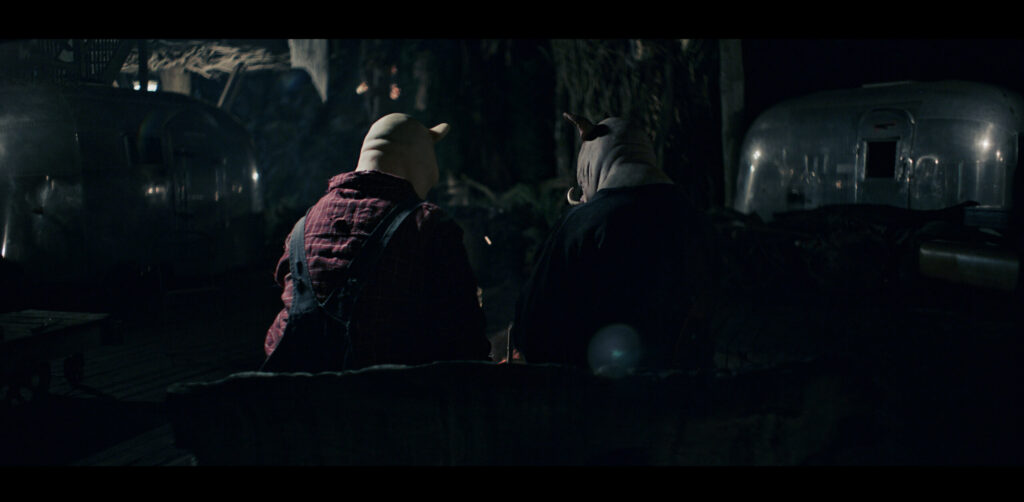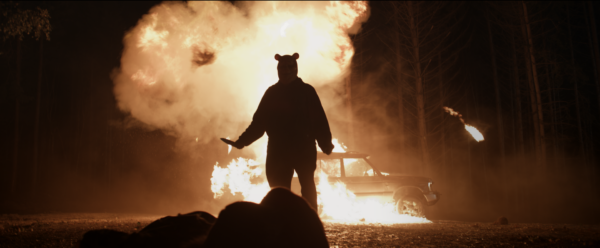When the first stills from Winnie-the-Pooh: Blood and Honey landed online in May of last year, the co-production from prolific genre film producers Jagged Edge and ITN Studios sparked an internet firestorm. A frenzy of media coverage followed for the indie-budget viral sensation, which sets a feral Winnie-the-Pooh and Piglet out on a bloody rampage. Acquired by Fathom Events, the anticipated slasher horror twist on A.A. Milne’s beloved bear hits theaters nationwide February 15th. In advance of the event cinema release, Boxoffice Pro spoke with director, writer, and producer Rhys Frake-Waterfield about the film’s theatrical release and his plans for further twisted tales.

There’s a lot of goodwill for the film. It’s garnered a swarm of media attention. Warehouse Cinemas even created a specialty cocktail for the release, complete with a mini honey dipper. How are you feeling going into the opening on February 15th?
I’m really excited, because it’s already had really good traction in Mexico. The box office numbers are now over $1 million, which is crazy, because their cinema tickets are incredibly cheap. It makes me want to go to Mexico and live there. They’re literally $3, and on Sundays they do 50 percent off that, so it’s $1.50 to see a film. To do a million there is actually pretty mad. It’s such good attendance.
I love to see horror succeeding. It’s across the board, really—you’ve got M3GAN doing incredibly well, Smile has done incredibly well, and so are the lower budget ones. Skinamarink has done really well recently; The Mean One was getting a bit of a theatrical release; Terrifier 2, obviously, that’s done super well. Relative to the budgets, there’s a lot of success coming from these films, which I love to see, because I’m a massive horror fan and I love it. It’s the genre I basically exclusively watch. So for me, I’m hopeful that this is going to get the same sort of traction in the U.S. as it has in Mexico and the rest of the world. If this proves successful, then I’m not going to stop here.
I have many other ideas, which I’m writing and making notes for. We’ve announced Bambi: The Reckoning and Peter Pan’s Neverland Nightmare, and they’re kind of Disney-linked ideas, but there’s so many others out there. There’s loads of folklore and nursery rhymes, which are synonymous with your childhood, and can get twisted in a new, horrific way. So if it’s successful, there’s going to be loads of these coming out, I promise.
Like a cinematic universe?
Exactly. Yeah, like the Marvel one.
Why do you think that children’s literature and stories from our childhood lend themselves so well to the horror genre?
I think first of all, it’s nostalgic. Everyone knows what these are, so there’s an element of marketability. Everyone has an idea of what this concept is, so it already grabs your attention. Also, a lot of them have darker origins anyway. A lot of the Grimm fairy tales and nursery rhymes have this dark backstory. Over the years, people have altered and removed the darkness out of it, and brought it into more of a child-friendly version. This is the chance to revert it back to what the true origins were, and take it down that darker route again. Lastly, I think they’re really contrasting. It piques people’s interest, because when you hear, ‘I’ve made a Winnie-the-Pooh horror film’, straight away people are like, ‘What?’ They become really curious. I saw a comment on YouTube yesterday, you probably won’t be able to say it in your article, but it’s the response I wanted. People want to know what you’ve actually done and how you’ve tried to achieve it.
When did you realize that these legacy literary characters, created by A. A. Milne, were entering the public domain?
I think it was about February of last year. We realized it was out there, and then I approached ITN Studios and said, ‘Do you want to co-finance this with us? We’ll try and make a really good Winnie-the-Pooh horror film.’ They said yes, so we both put 50/50 in and then kind of ran with the idea. I said I’d direct it, because I knew it had a lot of potential. When we want to make a film, we move fast. From the inception of the idea, it was about six or seven weeks before I was on set directing it, which is not much time at all. It’s got this hook, and it’s really grabbed people’s attention. The next one we do is going to be with a higher budget. We’re going to have all of these extra resources that can really show what we can do and what these films can really be. And that they’re refreshing and different.
The film has a robust release model for an event cinema title, with an initial nine day run via Fathom Events from February 15th through 23rd. Why was the event cinema route the best option for this film?
We kind of juggled between how to handle this at the start. I’m part of Jagged Edge—we were the filmmakers—so it’s our responsibility to say, ‘We think we should do this idea. Are you guys on board?’ and ITN said yes. Then we take the budget, and we just do what we want with it, basically. We decide how big the characters should be, what location should be used, etc. Once the film’s done, we give it to them, and they’re in charge of releasing and distributing it. We had many discussions about, ‘What should we do with this?’, because it’s really uncharted territory for us. We didn’t have a film which went to this sort of scale before, so we were kind of feeling our way through it.

Why was it important to have a theatrical release?
There were offers coming in from big companies to directly buy out the concept from the start. We had a discussion with them, but we thought, ‘No, we’ll try and do a theatrical release, because we think there’s the interest there. That it will get people in the cinema.’ Ultimately, that’s where a lot of the returns can come back from with these films. That’s what dictates its success. Then it started to expand out. South and Central America really jumped on it. They love Winnie-the-Pooh and horror, so they took it and agreed to do a full theatrical release in South and Central, then North America did initially a one day event, but now they’ve expanded it to a nine day event. Then all the other territories started having a similar thought, that they wanted to do a theatrical release. Now it’s getting released roughly everywhere. Which is mad to think, but yeah, it’s super exciting. Theatrical is the main way to get money back for the film. If we did it on DVD, what would probably happen is, day one it gets pirated, it goes online, people watch it there, and they don’t support the film. We’re a super indie production and that would have massive consequences for us. We’re very much reliant on hoping the film financially does well, in order to break into doing all of these new concepts and create this new kind of universe.
It’s a great strategy, because on the back of all this buzz, theaters are the only way to see it. It almost heightens the hype.
People would pay so much to get this level of exposure. We’ve got it purely based on it being a good concept. Having a good idea has made it spread globally, and that’s enough to drum up the interest for a theatrical release, which films like Knock at the Cabin are paying millions for.
Event cinema doesn’t tend to have multi-million dollar marketing budgets. How are you working with Fathom to market the film?
In terms of the cost behind marketing, there was none. We got to number two on IMDb’s Most Anticipated list with no money put into marketing or promotion at that point, which is crazy. Now that the film’s coming up to the release, we’re coordinating some efforts to help make sure people know what the date is. That’s a big thing for us. Even though there’s a lot of interest out there, we need to make sure everyone’s aware, February 15th is the day to go and see it in your cinema. There will be dates spanning beyond then, but it’s more limited screenings. They’ve got the trailer playing before a lot of films in the cinema like M3GAN, Knock at the Cabin, things like that, to try and draw in those sorts of audiences. They know it’s coming, but people sometimes need a little bit of a reminder. This is the date to go and see it. That’s the general idea, but we don’t have endless money, we’re quite small. Jagged Edge is literally, myself and [co-producer] Scott Jeffrey. So we can’t pump loads into these advertising campaigns, which cost hundreds of thousands or millions. We’re very much reliant on this word of mouth route to help get the message out there. Hopefully, if it’s successful, and it does well, then we could do more and we will have the potential to do those sort of routes in the future.
Are horror fans your target audience? Do you feel that there’s a broader audience beyond horror fans that will want to go out and see this?
The film is made for horror fans, so I’m hoping they’re the audience which are going to enjoy it the most. It probably stretches beyond the horror audience, because it’s such a wacky and weird concept. Some people are just genuinely really interested in how Winnie-the-Pooh could be a horror movie. In comparison to films like Terrifier 2, which is pure horror, their entire audience is probably the horror audience. Whereas something like M3GAN might dip more into other kinds of cinema goers or genre lovers. I think Winnie-the-Pooh might be somewhere in between them. It’s really hard for me to say exactly at this moment, but based on the word of mouth element of this, and how viral it’s gone, that’s not just horror fans. That’s a lot of other people who are just generally interested.
Horror movies are always more fun in the theater with a group of strangers. What can audiences expect to experience, seeing this film in a theater?
At the moment, there’s a lot of grounded horror out there. It’s got a dramatic undertone to it and it’s very serious. This isn’t serious. It’s supposed to be a fun, entertaining film. You’re supposed to watch this and allow yourself to laugh. I didn’t want to go too deep with it or take it too serious, because ultimately, it’s Winnie-the-Pooh with a knife. You can’t have this heavy, dramatic undertone with everything. I think it would just be boring. You want to see him doing crazy, weird things. That’s the route I’ve taken it down. There are bits intended to be funny and intended to be a bit campy. So I hope people aren’t worried about laughing, because that’s what I want. There are some serious bits, it glides between the two, but also you’re supposed to be enjoying it and laughing. And you’re right, being in a theater, hopefully it becomes more contagious, that everyone’s laughing at the same sort of bit. It just becomes a better experience that way.




Share this post